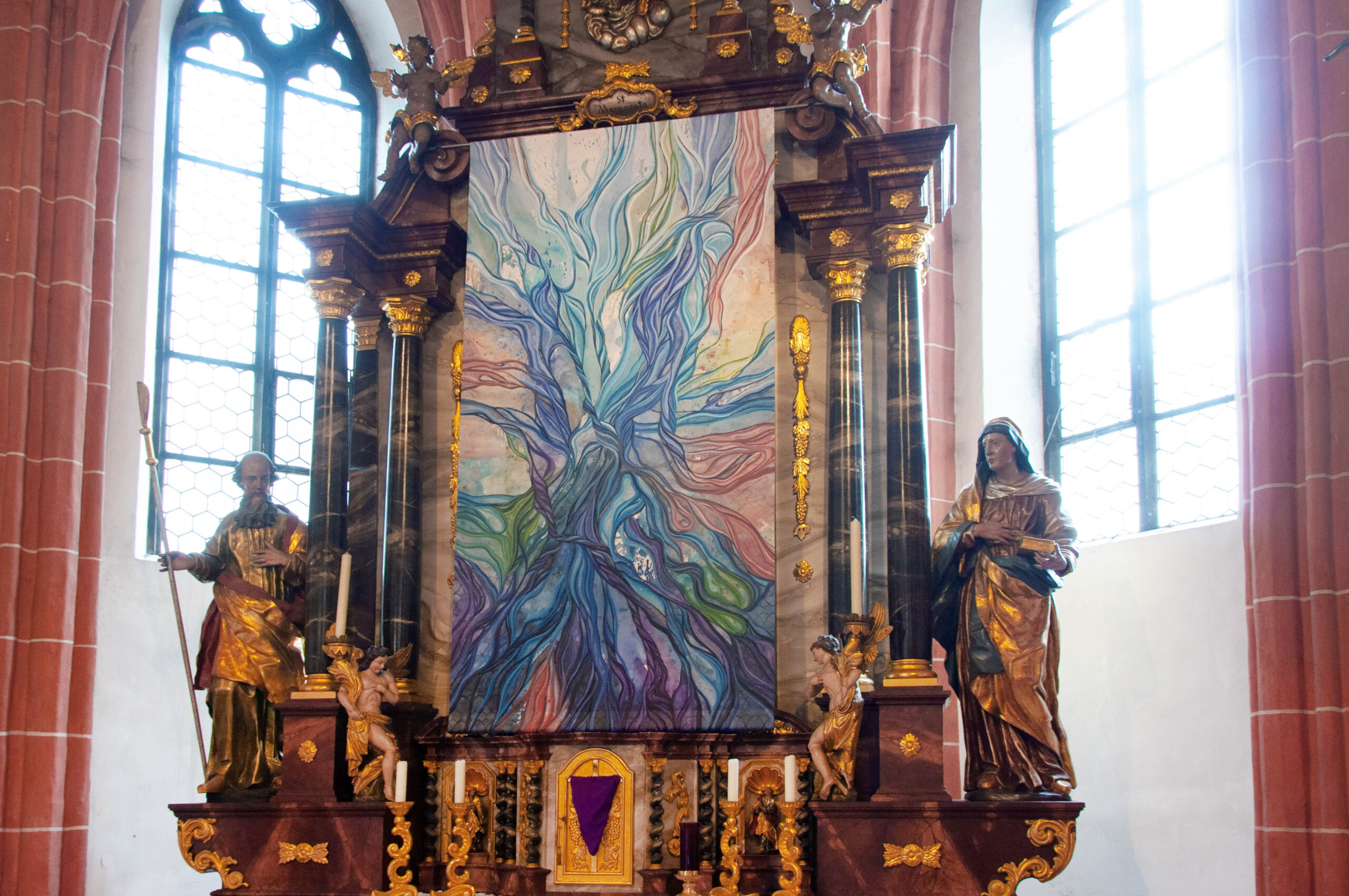Ein Fastentuch verbirgt das oft Gesehene und Vertraute, die Bilder des Hochaltars und das Kreuz. Es fordert uns auf, auch „mit den Augen zu fasten“. Keine vorgegebenen Bilder zu sehen, sondern die eigenen zu suchen. Keine bekannten Erzählungen zu deuten sondern die eigene Geschichte zu ergründen. Kein Wissen zu wiederholen, sondern eigene Fragen zu stellen.
Es wirft uns zurück auf uns selbst.
Halt an! Wo läufst du hin? Der Himmel ist in dir! Suchst du Gott anderswo, du fehlst ihn für und für.
Angelus Silesius
Dieser Gedanke des bekannten Mystikers aus dem 17. Jahrhundert begleitet mich schon lange und wurde für mich Ausgangspunkt und Inspiration meiner Arbeit am Fastentuch.
Mit den Mitteln der Farben, der Linie und der Form habe ich versucht ein Werk zu schaffen, das uns auf diesem suchendem Weg begleiten kann. Ich möchte damit ermutigen, das Göttliche im Dasein zu finden, den eigenen Lebens- und Glaubenswegen nachzugehen, aus der Tiefe zu schöpfen und dem Himmel entgegenzuwachsen.
Ich lade alle ein, beim Betrachten des Fastentuchs in eine Welt voller Verbindungen, Verwurzelungen und Verzweigungen einzutauchen. Verwobene und verknotete Schleifen und Stränge wachsen in dem Bild aus der Tiefe und breiten sich in die Höhe hin aus. Vieles können wir darin sehen.
Wellen, die tragen
Seile, die Halt geben
DNA-Stränge, Geheimnisse des Lebens in sich tragend
Eine Nabelschnur, die mit dem Ursprung verbindet
Organische Geflechte, wie Adern uns durchziehend
Verbindungen zueinander
Wege und Umwege unseres Lebens
Spuren, eingewoben in eine Welt der Farben
Blau durchzieht das Bild in vielen Farbnuancen und verbindet alles miteinander. Es ist die Farbe der Unendlichkeit, des Himmels und der Weite, des Wassers und der Tiefe. Blau lässt uns zur Ruhe kommen und zugleich Atem holen. Viele sehen darin auch die Farbe des Glaubens.
Violette Spuren tauchen im unteren Bereich des Bildes wie aus der Tiefe auf. Violett ist die Farbe der Besinnung, des Nachdenkens, der Reflexion. Eine Farbe, die zwei Welten verbindet – das Blau des Himmel und das Rot der Erde. Daher ist sie auch die Farbe, die uns auf die großen Feste des Christentums vorbereitet – Ostern und Weihnachten.
Grüne Bereiche durchdringen an manchen Stellen das Bild. Es ist die Farbe der Hoffnung, des Lebens, des Wachsens und der Schöpfung. Grün ist wie ein Versprechen, es bedeutet Neuanfang, Vertrauen und Zuversicht.
Rottöne sind in das Fastentuch eingewoben. Rot ist die große Farbe der Liebe und Hingabe, des Schmerzes und des Glücks. Rot steht für Leidenschaft und Leiden, es ist die Farbe der Erde, die alles Menschliche in sich vereint. Hier verbindet diese Farbe das Bild auch mit dem umgebenden Kirchenraum, der von diesem warmen Rotton wie von einem Netz durchzogen ist.
Das ganze Fastentuch ist zudem geprägt von einem filigranen, ornamentalen Muster. Wie ein Pulsschlag ist es da, manchmal ganz zart und verborgen, an anderen Stellen deutlich erkennbar. Wofür es steht, bleibt offen: Das Vertrauen ins Leben, das Miteinander, der Glaube, Gott oder doch ganz etwas anderes.
Im Betrachten des Fastentuches können wir uns vielleicht wiederfinden zwischen Tiefgründigem und Leichtigkeit, Dunklem und Hellem, Fragen und Zweifeln, Vertrauen und Wagnis, Verbundenheit und Loslösung, Himmel und Erde.
Dabei dürfen wir uns getragen und geführt fühlen und zugleich suchend bleiben, den Wegen des Lebens trauend.
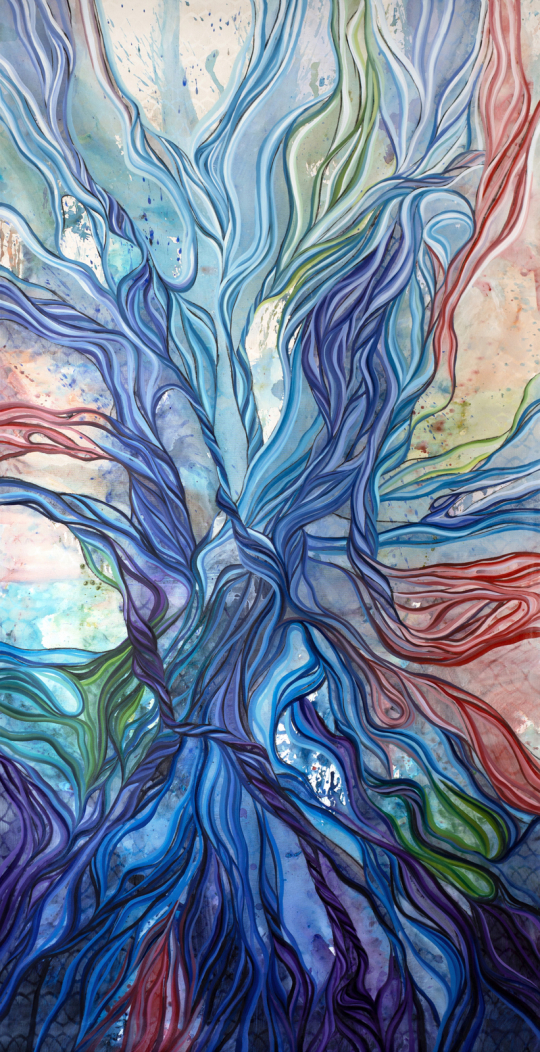
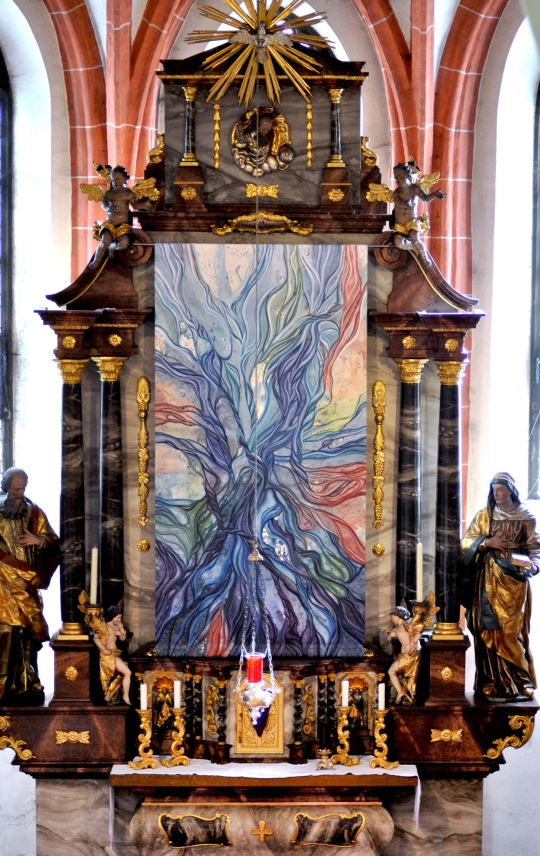
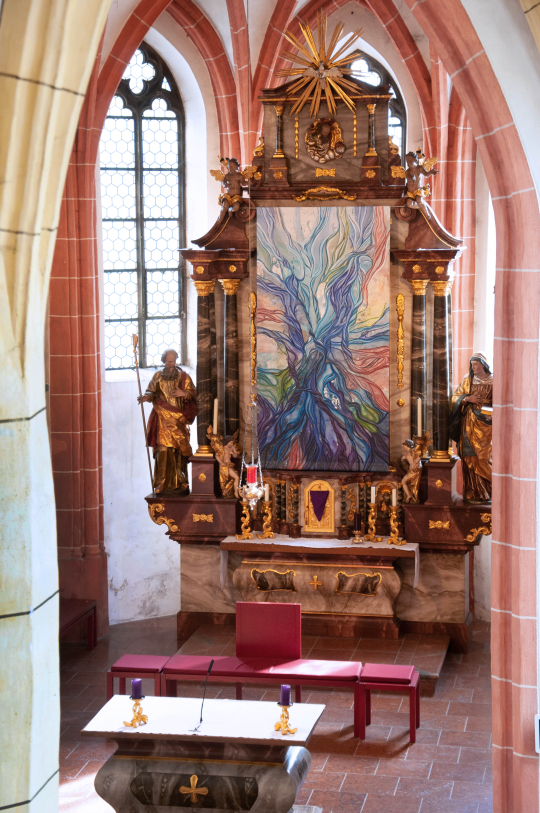
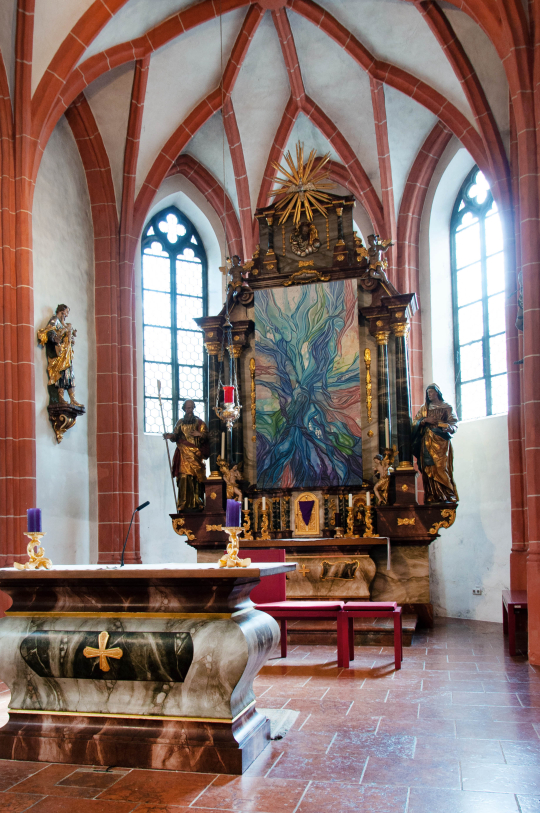
Lenten cloth „Search“
A Lenten cloth hides the often seen and familiar, the images of the high altar and the cross. It invites us to „fast with our eyes“. Not to see predetermined images, but to look for our own. Not to interpret familiar stories, but to explore our own history. Not to repeat knowledge, but to ask our own questions.
It throws us back on ourselves.
Hold on! Where are you going? Heaven is within you! Are you looking for God elsewhere, you are miss him for and for.
Angelus Silesius
This thought by the famous 17th century mystic has been with me for a long time and became the starting point and inspiration for my work on the Lenten cloth.
Using the means of colour, line and form, I have tried to create a work that can accompany us on this searching path. I would like to encourage people to find the divine in existence, to follow their own paths of life and faith, to draw from the depths and to grow towards heaven.
I invite everyone to immerse themselves in a world full of connections, roots and ramifications when looking at the Lenten cloth. Interwoven and knotted loops and strands grow in the picture from the depths and spread upwards. We can see many things in it.
Waves that carry
Ropes that give support
DNA strands, carrying the secrets of life within them
An umbilical cord that connects to the origin
Organic networks that run through us like veins
Connections to each other
Paths and detours of our lives
Traces, woven into a world of colours
Blue runs through the picture in many colour nuances and connects everything with each other. It is the colour of infinity, of the sky and vastness, of water and depth. Blue allows us to calm down and catch our breath at the same time. Many also see it as the colour of faith.
Violet traces emerge in the lower part of the picture as if from the depths. Violet is the colour of contemplation, of reflection. A colour that connects two worlds – the blue of the sky and the red of the earth. It is therefore also the colour that prepares us for the great festivals of Christianity – Easter and Christmas.
Green areas permeate the picture in some places. It is the colour of hope, of life, of growth and of creation. Green is like a promise, it means new beginnings, trust and confidence.
Shades of red are woven into the Lenten cloth. Red is the great colour of love and devotion, of pain and happiness. Red stands for passion and suffering, it is the colour of the earth that unites everything human. Here, this colour also connects the picture with the surrounding church interior, which is permeated by this warm shade of red like a net.
The entire Lenten cloth is also characterised by a filigree, ornamental pattern. It is there like a pulse, sometimes very delicate and hidden, in other places clearly recognisable. What it stands for remains open: Trust in life, togetherness, faith, God or something else entirely.
By looking at the Lenten cloth, we can perhaps find ourselves between profundity and lightness, darkness and light, questions and doubts, trust and risk, connection and detachment, heaven and earth.
We can feel carried and guided and at the same time remain searching, trusting the paths of life.
